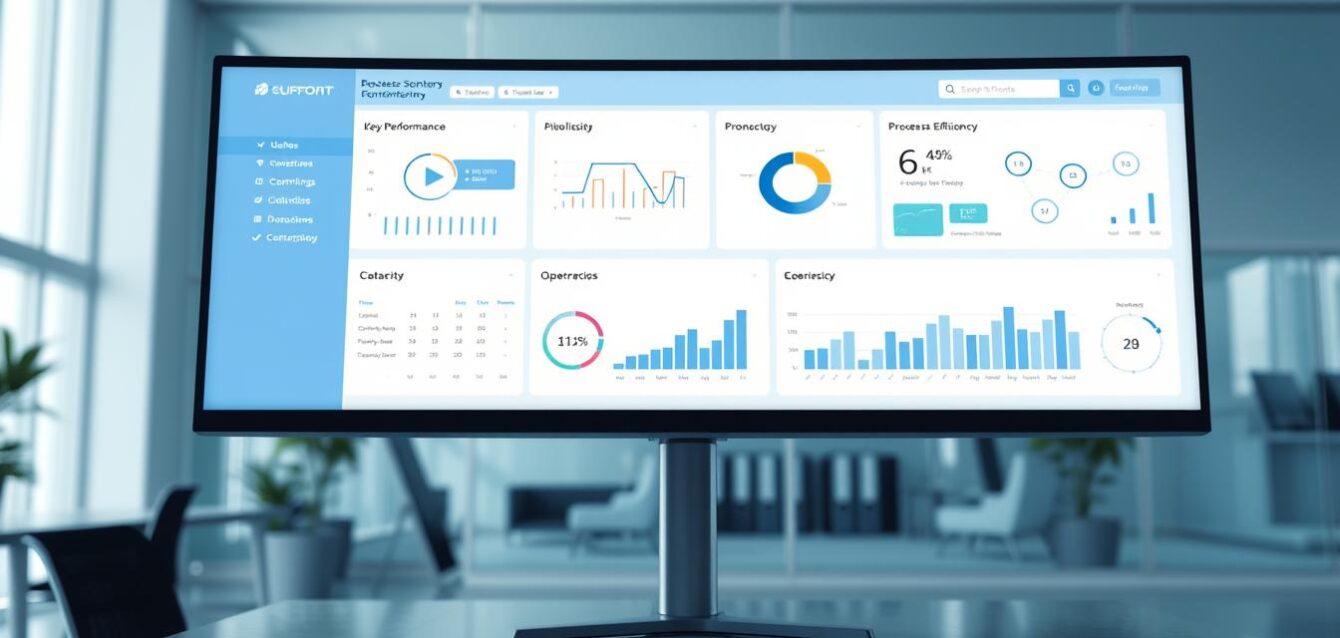Most organizations face challenges in achieving smooth digital transformation. Sadly, 70% of these efforts fail to reach their goals. A big reason for this is the lack of clear sight into business processes. These processes are the core of today’s businesses.
Business processes are key to an organization’s success. They help companies work well, change quickly, and serve their customers better. Yet, many of these processes are not watched closely enough. This leads to wasted time and missed chances. With business process observability, companies can see what’s happening in real time. They can spot problems and make things better.
Key Takeaways
- Business process observability is key for a successful digital transformation.
- Not seeing what’s happening in business processes can cause problems and missed chances.
- Real-time insights help companies find and fix issues, making things better.
- Business process observability lets companies change faster.
- Being able to see what’s happening leads to better service for customers.
Understanding Business Process Observability in the Modern Enterprise
In today’s complex business world, knowing about business process observability is key. It shows how well processes work by looking at data from each step. This uses the right system monitoring or interfaces.
Defining Business Process Observability vs. Traditional Monitoring
Business process observability is different from old monitoring ways. Old monitoring looks for oddities, but observability digs deep into how businesses run. It checks data from logs and APIs to find the real problem, not just signs of trouble.
The Evolution of Process Visibility in Business Operations
The need for clearer and more accountable business operations has led to observability’s growth. As businesses got more complex, the need for quick insights into their workings grew. Now, with advanced analytics and AI, businesses can make smarter choices based on real-time data.
| Key Features | Traditional Monitoring | Business Process Observability |
|---|---|---|
| Focus | Anomaly detection | Comprehensive understanding of business operations |
| Data Sources | Limited to specific metrics | Log files, APIs, and other data sources |
| Insights | Symptom detection | Root cause analysis |
The Importance of Business Process Observability for Organizational Success
In today’s fast-paced world, success in business goes beyond just watching numbers. It needs deep insight into how things work. With observability, companies can see what’s happening in real time. This lets them quickly adapt to changes and challenges.
Bridging Operational Silos Through End-to-End Visibility
Business process observability is key because it connects different parts of a company. It shows how each part works together. This helps teams work better and solve problems together.
Seeing everything clearly helps businesses run smoother and avoid mistakes. For example, if a problem pops up, tools can find the source fast. This makes fixing the issue easier for everyone involved.
Enabling Data-Driven Decision Making in Real-Time
Observability lets companies make smart choices based on current data, not just past numbers. This is vital in today’s fast-changing world.
With up-to-date insights, leaders can act fast on new trends and problems. This means they can grab chances and avoid risks. Experts say, “Observability isn’t just about data. It’s about using the right data at the right time.”
“The competitive advantage that comes with making a decision based on what’s happening right now instead of on last month’s trends is significant.”
Proactively Identifying Process Bottlenecks and Inefficiencies
Observability also helps find and fix problems before they get big. By watching processes closely, companies can spot and fix issues early. This keeps things running smoothly and saves time and money.
- Identify bottlenecks and inefficiencies in real-time
- Improve process efficiency and reduce waste
- Enhance customer satisfaction through optimized processes
By using observability, companies can stay ahead by being quick, responsive, and efficient. As businesses face more challenges, the role of observability will grow even more important.
Key Benefits of Implementing Robust Process Observability
Process observability helps businesses stay ahead in today’s quick-changing world. It makes operations better, boosts customer happiness, and supports digital changes.
Enhancing Operational Efficiency and Resource Allocation
Process observability boosts operational efficiency by giving real-time insights. It helps spot and fix problems, making use of resources better. This leads to lower costs, more work done, and better results.
Improving Customer Experience Through Process Optimization
Process observability is key to better customer experiences. It lets companies fine-tune their processes and meet customer needs better. By looking at process data, they can find ways to improve, cut down on wait times, and make customers happier.
Accelerating Digital Transformation Initiatives
Robust process observability is vital for speeding up digital changes. It gives insights into processes, helping find where digital tools can help improve. This keeps businesses competitive and helps reach digital goals.
In short, using process observability well can really help a business. It makes them more agile and efficient. By making operations better, improving customer service, and speeding up digital changes, companies can stay on top in today’s fast world.
Overcoming Challenges in Adopting Business Process Observability
The path to business process observability is filled with hurdles. These include integration problems, cultural barriers, and picking the right tools. To fully benefit from observability, these challenges must be overcome.
Technical Integration Across Legacy and Modern Systems
One big challenge is linking monitoring tools for business process observability with different IT systems. This means connecting old systems with new cloud apps. It’s all about making sure data flows well and we see everything clearly.
Building a Culture of Process Transparency and Accountability
To adopt business process observability, a cultural change is needed. It’s about being open and taking responsibility. Teams should focus on making processes better using data.
Selecting the Right Observability Tools and Frameworks
The importance of business process observability is huge. Choosing the right tools is key. Look for solutions that give full visibility, real-time data, and work with your current systems.
By tackling these challenges, companies can fully use business process observability. This leads to better operations and happier customers.
- Enhance technical integration for complete visibility
- Foster a culture of openness and responsibility
- Select tools that offer full visibility and real-time data
Conclusion: Driving Business Agility Through Process Observability
Business process observability is now a must for companies wanting to succeed. It helps them stay ahead in today’s fast world. With good process observability, businesses see big wins like better efficiency, happier customers, and faster digital growth.
Good business process monitoring lets companies spot and fix problems fast. This way, they can make smart choices quickly. As they face ups and downs, focusing on observability is key for growth.
Observability is not just a quick fix. It’s a long-term effort to get better at what you do. Companies that focus on it will be more agile. They can easily adapt to new market trends and customer wants.
FAQ
What is business process observability, and how does it differ from traditional monitoring?
Business process observability gives a full view of business operations in real-time. It uses data from many sources to understand processes fully. Unlike old monitoring, which looks at parts, observability sees the whole process. This helps find and fix problems early.
How does business process observability enhance operational efficiency?
Observability offers real-time insights into business processes. This helps organizations use resources better, make operations smoother, and cut waste. It boosts efficiency, productivity, and decision-making.
What role does AI play in business process observability?
AI is key in observability, helping analyze lots of data, find patterns, and predict problems. AI insights help make decisions early, keeping businesses ahead.
How can organizations overcome the challenges of adopting business process observability?
To adopt observability, focus on technical integration, cultural changes, and the right tools. Build a culture of openness and accountability. Invest in technologies for full process visibility.
What are the key benefits of implementing robust process observability?
Robust observability boosts efficiency, improves customer service, and speeds up digital changes. It uses analytics and AI to drive these benefits and increase business agility.
How does business process observability support digital transformation initiatives?
Observability is vital for digital transformation by giving real-time insights. It helps spot and fix areas for improvement, making operations better and speeding up digital changes.
What are the best practices for selecting observability tools and frameworks?
Choose tools based on scalability, flexibility, and integration with current systems. Look for tools that offer full process visibility, real-time insights, and AI analytics for observability.




